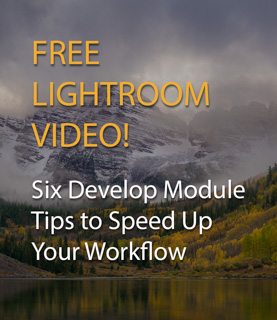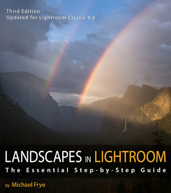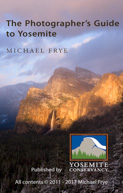Vision and Creativity
by Michael Frye | Nov 13, 2014 | Composition, Light and Weather, Vision and Creativity
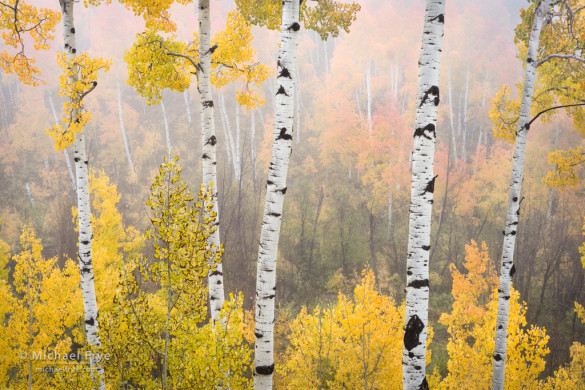
Aspens in fog near Ridgway, CO
Claudia and I have been busy since our trip to Colorado in early October, so I haven’t had a chance to post more images from our travels until now. But maybe that’s a good thing, as that time has given me a chance to reflect on the journey.
It had been a dream of mine to photograph the autumn aspen display in Colorado, and it more than lived up to my expectations. Colorado veterans said it was the best fall there in many years, and it certainly looked good to us. The sheer number of aspens covering the hillsides was astonishing.
The problem was that I didn’t know the area. At all. I’m usually writing about photographing Yosemite, or maybe the aspens on the eastern side of the Sierra, places that I know intimately. That knowledge is a big advantage, giving me a greater chance of being in the right place at the right time to take advantage of the light, weather, and conditions.
(more…)
by Michael Frye | Oct 29, 2014 | Photography Tips, Vision and Creativity
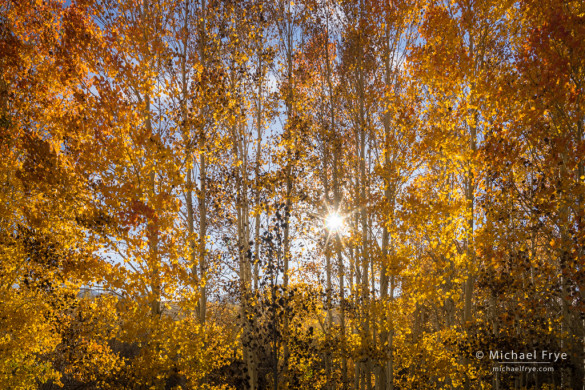
Late-afternoon sun in an aspen grove, Eastern Sierra. Backlight makes autumn leaves glow, but to avoid lens flare you have to either shade the lens (if the sun is out of the frame), or partially hide the sun behind a tree, as I did here.
Light is a vital aspect of any photograph, and always the first thing I think about when deciding where to go with my camera. The more you understand light, the better your photographs will be.
Any kind of light can work for fall color – under the right circumstances. But some kinds seem to work better than others. While photographing and leading workshops in the eastern Sierra, I was usually looking for backlight or soft light on the aspens – or best of all, soft backlight.
(more…)
by Michael Frye | Aug 6, 2014 | Composition, Vision and Creativity
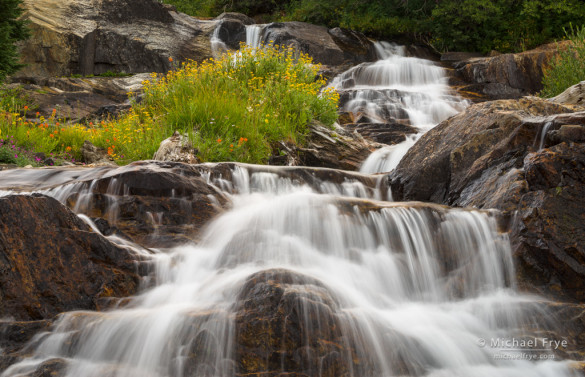
Wildflower island and cascade, eastern Sierra; 100mm, 1/2 sec. at f/16, 100 ISO
It’s been an interesting summer in the Sierra. Last winter was one of the driest on record, but over the last month or so we’ve seen a steady flow of monsoonal moisture flowing up from the southeast, leading to frequent afternoon showers and thunderstorms over the higher elevations. We even heard about an epic deluge two or three weeks ago that flooded the parking lot and some of the tent cabins at the Tuolumne Meadows Lodge.
That extra moisture has kept the streams flowing and flowers blooming in the high country longer than I would have expected. On Saturday Claudia and I hiked up one of the eastern Sierra canyons and found a pretty series of cascades, with an island of late-summer flowers in the middle.
Although I make my share of black-and-white photographs, I’ve always been attracted to color. I often look for color, then try to build a composition around it. As I tell my workshop students, color isn’t enough – you need to find a design to go with that color.
In this case, that design proved to be elusive. The most obvious composition was a wide-angle view with a patch of flowers at the bottom, and the upper cascade above. But there was a distracting pile of logs at the base of the cascade that cluttered the image, with no obvious way to eliminate or minimize the logs. I have nothing against logs, but in this case I was interested in the flowers and water, and the logs broke up the visual flow between the flowers and water, diluting the photograph’s message:
(more…)
by Michael Frye | Jul 30, 2014 | Vision and Creativity
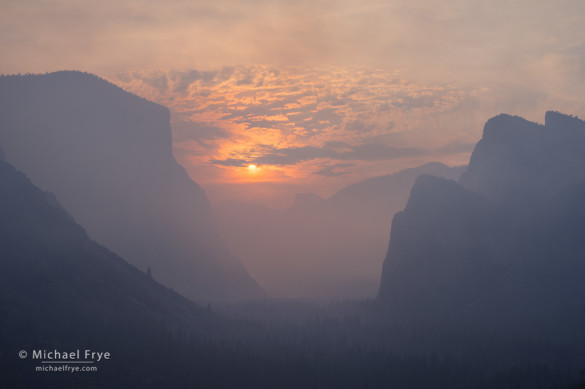
Sun rising through smoke from Tunnel View, 7/28/14, Yosemite NP, CA, USA
Early Monday morning I drove up to Yosemite Valley, hoping that smoke from the El Portal and Dark Hole fires might create some interesting atmospheric effects. Yes, I went looking for smoke, something that photographers usually avoid. But smoke can impart a wonderful, ethereal quality to photographs – like fog, but with more color.
At Tunnel View the smoke was thick enough to give the scene a misty, painterly look, but not so thick that you couldn’t see anything. Eventually the orange ball of the sun appeared through the smoke, accompanied by a patterned cloud formation (above). Later, along the Merced River, the smoke lent a similar painterly mood to scenes of El Capitan and Three Brothers (below). And much later, near sunset, the sun turned into an orange ball again as it sunk into the smoke to the west (below).
(more…)
by Michael Frye | Feb 6, 2014 | Vision and Creativity
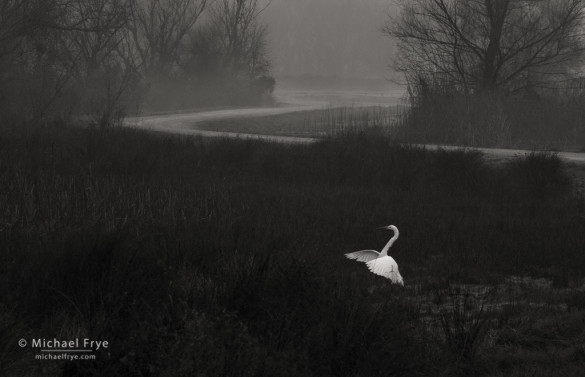
Great egret landing, San Joaquin Valley, CA, USA
This image was a lucky accident. I was standing next to my car along a tour route at one the wildlife refuges in the Central Valley, looking at a large flock of sandhill cranes and Ross’s geese, when I saw this egret flying by. I quickly turned, pressed the autofocus button on the back of the camera, followed the bird, and held the shutter button down as the egret landed.
The photograph languished in my archives for awhile before I processed it. Maybe I didn’t realize its potential right away because it was such a grab shot. But I did finally process it recently, and found several things to like about it.
First, there’s the contrast. Most of the frame is dark, but the two key elements – the bird and the road – are lighter, so they stand out. Any time you can place a light subject against a dark background, and have that subject stand out cleanly and distinctly against its surroundings, you have the potential for a strong image. There’s no sunlight in this photo, so the contrast isn’t created by sun and shade, but by the juxtaposition of a white bird against dark vegetation. But it doesn’t matter how the contrast is created, as long as it’s there. (The same idea also works for dark subjects against light backgrounds. I talk more about both kinds of contrast in this post.)
(more…)
by Michael Frye | Dec 18, 2013 | Announcements, Vision and Creativity
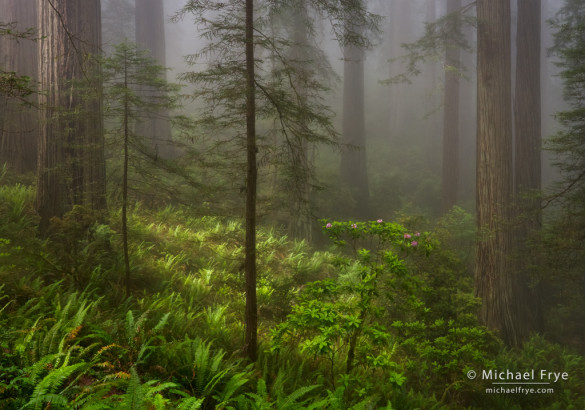
Redwoods, ferns, and rhododendrons near the northern California coast, USA
Continuing our look at back at the most popular posts of 2013, here’s one that’s been extremely popular – in fact it’s my most-read post ever. It’s from January 2013, and it’s called Creating Depth: Beyond the Wide-Angle Formula.
This post looks at some alternatives to the popular, wide-angle, near-far look that you see in so many landscape photographs – alternatives like atmospheric effects, subtle perspective clues, and size comparisons. And the article also explains why many photographs and paintings with a sense of depth have something in common that’s not immediately obvious.
To all of you who read this article, commented, or wrote me an email response, thanks very much! Your participation makes writing this blog fun, and I know your comments make reading it more enjoyable for everyone.
— Michael Frye
Michael Frye is a professional photographer specializing in landscapes and nature. He is the author or principal photographer of The Photographer’s Guide to Yosemite, Yosemite Meditations, Yosemite Meditations for Women, and Digital Landscape Photography: In the Footsteps of Ansel Adams and the Great Masters. He has also written three eBooks: Light & Land: Landscapes in the Digital Darkroom, Exposure for Outdoor Photography, and Landscapes in Lightroom 5: The Essential Step-by-Step Guide. Michael written numerous magazine articles on the art and technique of photography, and his images have been published in over thirty countries around the world. Michael has lived either in or near Yosemite National Park since 1983, currently residing just outside the park in Mariposa, California.







